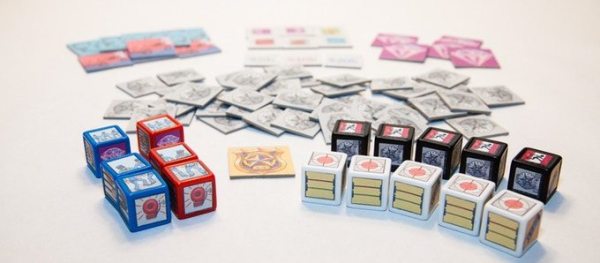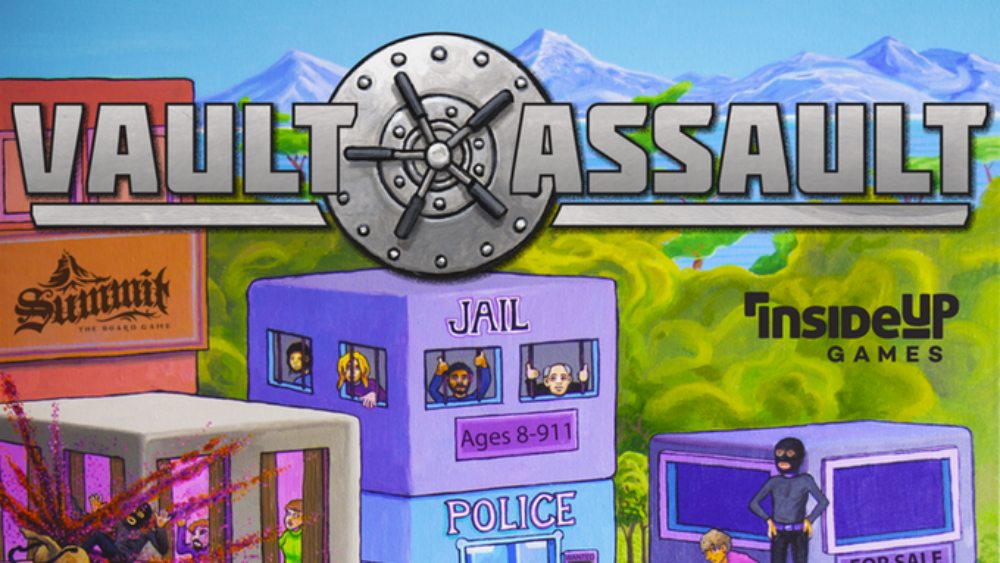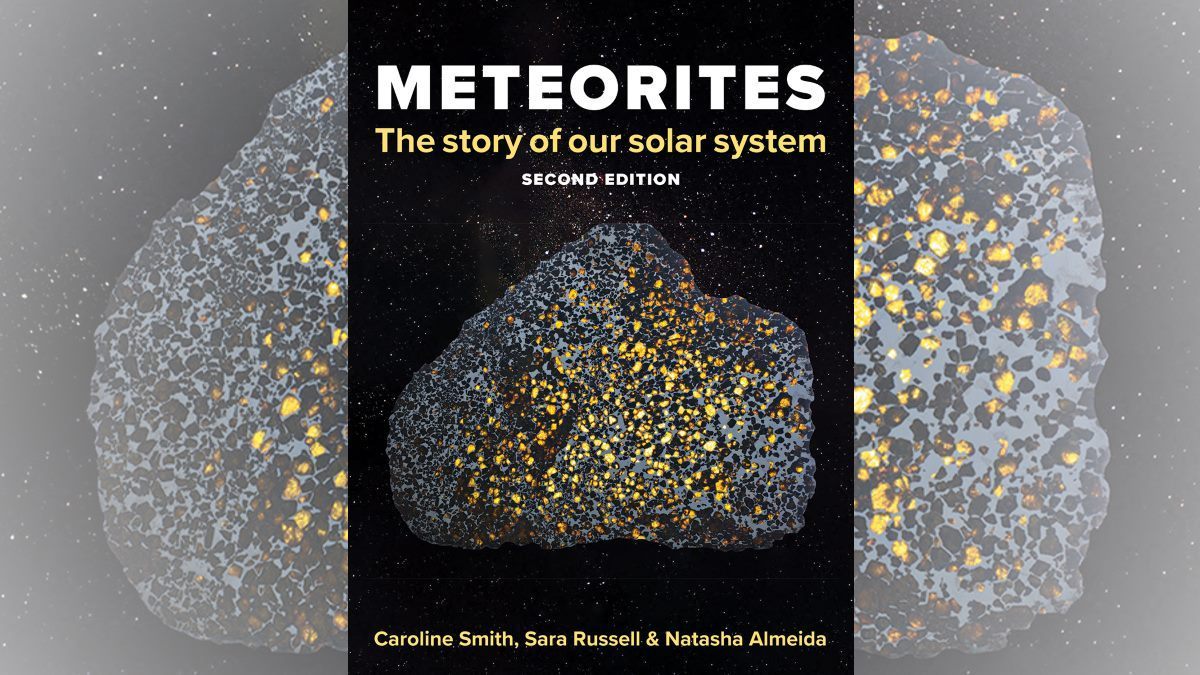
Whether you enjoy being the bad guys or the good, Vault Assault will satisfy your good old fashioned cops and robbers cravings in under 20 minutes.
At a glance:
Vault Assault is a fast-paced dice rolling game for 2-4 players. This is developer Conor McGoey’s (rhymes with McCoy) second Kickstarter game, and you can make your pledge on the campaign page for $29CAD (about $23 USD) + shipping for one copy of the game and all stretch goals.
Players take turns playing as cops or robbers for 2 or 3 rounds, depending on the number of players. In each round, players will swap rolls and they are completed when each player or team has played as the cops one time. The robbers try to steal as much money and as many diamonds as they can before getting caught. The cops will, of course, try to catch the robbers before they make off with the loot. For 2 or 4 players, that will be 2 rounds and for 3 players there will be 3 rounds. For 4 player games, there are 2 cops and 2 robbers and they play as teams to complete the goals.
There is no recommended age range in the Kickstarter details, but my 12-year-old son picked up the rules after one read through so I’d say this game would be fine for 7-8 years of age.
New to Kickstarter or curious how we handle crowdfunding at GeekDad? You can view our crowdfunding primer and then find a list of projects we love.
Vault Assault Components:
Rules Sheet
Dice
- Robbers – 10 Dice
- Cops – 6 Dice
Tiles
- Vault – 54 Tiles
- Getaway Cards – 9 Tiles
- Diamonds – 5 Tiles
- Round Marker – 1 Tile
I used a prototype set for this review, so the components, style, and artwork may change before production of the final game. Keep tabs on the Kickstarter page for any changes to the components and artwork.

How to Play Vault Assault:
The full rules are available to download as a PDF.
The Goal
The player or team with the most loot at the end of the game wins. You will play each round with the goal of gathering and keeping as much loot as possible (as either vault money or diamonds or a combination of the two) while trying to swipe loot from other players to reduce their amount and increase your own. So when you are playing as the robber, you want to gather as much loot as possible, and when you’re a cop, you want to end the round as quickly as possible to minimize the amount of loot the robbers are able to take. And if you manage to capture the robber(s) before they escape, you get to impound some of their loot to increase your own stash and increase your odds of winning.
Setup

The rules sheet has an excellent graphic to help you setup the game for any number of players. For a 2-player game, you will set up one cop and one robber across the table from each other with the vault tiles piled face down between the players.
We played a 2-player game, so we set up with 5 dice each across from each other so it was easy to line up the dice. The cop (me for the first part of the round) has 5 dice set up behind a barrier (the game suggests using your hand, but Mama needed that hand for her camera). I set my dice all to the alarm bells and then chose one to flip to the diamond and one to flip to the dye pack without letting the robber see what I was doing. Then, I put my 3 getaway cars behind the dice. The robber (my son) turned his 5 dice all to the wires and put his 3 getaway cars behind them. No need to hide in this case; there are no other robbers, and the cop needs to see when the robber(s) start flipping dice.
Taking a Turn
Vault Assault is a little different than most typical tabletop games. Your actions are mostly done all at the same time, so there is no actual “turn taking.” However, I’ll use this category to discuss how the rounds work because that was the part of the instructions I struggled with the most. Here is a quick video overview of our setup and our first playthrough of the Diamond Heist phase of round 1.
The Diamond Heist phase begins with the robber choosing 1 die to flip to indicate he is cutting that wire in the security system of the vault. The cop compares that to their dice and lets him know the result of his choice. Then the robber can choose to continue flipping dice or to stop and proceed to the Vault Assault phase.
Let’s go through all the possible results of flipping the dice in this phase. If the die the robber flips matches up to 1 of the alarm dice for the cop, the cop gets to start the Diamond Heist phase with 1 piece of the mosaic already set. If the robber hits 2 alarms, the cop starts with 2 parts of the mosaic already set.
If the cut wire die matches up to the dye pack (the trap), the robber must flip that die to the hostage side, and when the Diamond Heist phase starts, he can’t roll that die until he gets it back via rolling a successful Backup! roll.
If the cut wire die matches the diamond die, the robber gets to take and keep that diamond.
In our game, the robber chose to go for the diamond even after hitting the dye pack and having to turn one of his starting dice to the hostage side. He managed to get the diamond on the third cut, which cannot be taken away and is worth $40,000 when it is time to tally the loot totals, so this paid off well for him. You may catch in the video that we forgot the rule where if he hit an alarm on his first wire cutting I was supposed to start the Vault Assault phase with 1 part of my mosaic set. But we did catch that he needed to flip 1 of the dice to the hostage side and start off the next phase with 4 rollable dice instead of 5.
Once you are finished with the Diamond Heist phase, you move on to the Vault Assault phase which is where things get pretty frantic but very hilarious. I have a video of us going through the Vault Assault phase as well. It is a bit longer and a bit shakier, as I was filming and rolling and watching both sides for rules and such but we had a great time. I just wish I’d had time to do a real voice over with instructions, but I hope this helps. I’ll also walk you through the major points here in the article.
You’ll see my son quickly rolled Backup! in the video and got his hostage die back into play and then almost immediately rolled Hostage! again which made me have to start my mosaic over. In this phase, the robber can roll any of the sets for Steal, Loot, Hostage, Backup, or Escape at any time according to his changing goals. As the robber, you’ll need to decide how much loot is enough to move to try to escape or you’ll risk being arrested by the cop. For the cop, you have to go through the mosaics in the order indicated, with the chance to roll 4 x Dye Pack dice before each of those stages to swipe some loot from the robber’s getaway cars. The robber in this game took the tactic of trying to screw with the cop as long as possible, but I eventually worked my way through all 4 mosaics and he was arrested. I then took one of his getaway cars to impound and added the loot from that card to my stash.
Here is the breakdown of the goals for both the robber(s) and the cop(s) for this phase. The rules sheet explains all exceptions and limitations well, as shown below. Loot is gathered by the robbers when they roll 4 of the vault dice and are able to take 2 Vault tiles and place them in any of their getaway cars. Loot is gathered by the cops by rolling 4 of the dye pack dice where they get to swipe 2 of the vault tiles from the robber’s getaway cars OR when the robbers are arrested and one of the getaway cars is impounded. The choice of car is up to the cop, but he or she cannot look through the loot stacks to choose, it has to be done as is.

From this point, you swap roles so that the person who was the cop is now a robber and the person who was a robber is now a cop. You go through both phases (Diamond Heist and Vault Assault) again but keep your getaway cards with their stashes (including diamonds you took) and that is the end of the first round. In a 2- or 4-player game, you play 3 rounds and in a 3-player game, you play 2 rounds, playing as teams with the changes in # of dice as outlined in the rules sheet.
Ending the Game
The game ends after all rounds are complete. The total loot amounts are added up and the person with the highest amount of loot is the winner.
The Verdict
First, don’t be fooled by how slowly we rolled in the video above. That was only so I could keep an eye on our actions and record as best I could. In a full game of Vault Assault, the final phase will be total mayhem with everyone rolling and building sets/mosaics as fast they can while people are screaming out results and doing the corresponding actions. It gets the adrenaline going, causes frustration and laughter numerous times and was really fun to play. It was even better our second time through when we weren’t recording and could just relax and play.
Is Vault Assault Difficult to Learn?
We did not find Vault Assault hard to learn at all. I think it would benefit from some expansion in the rules sheet, perhaps showing each of the 2-, 3-, and 4-player board setups entirely, but overall we were able to learn it quickly from the rules as written. I think some foldable card stock screens to hide dice as appropriate would make the Diamond Heist phases much easier, but that was the only other struggle we had. As you can see from the videos we created our own screen for our demo.
Is Vault Assault Fun to Play?
Yes! We had a lot of fun, and I can see this being yet more fun with teams. Adding in the coordination of goals to the rolling will make the Vault Assault phase even more manic, which is a good thing. The only complaint we had was with the need to hide your dice with your hand it impacted your ability to do other things. My son still likes to roll dice with two cupped hands, so if our game had involved 3 or 4 players instead of 2, we’d have had to improvise multiple screens.
Oh, I didn’t go over the special tiles one might find when gathering vault tiles. There are 6 specialty cards that result in the following:
Drawing a vault tile with a picture of a man running in a circle instead of a dollar amount means you must either immediately run a lap around the table or try to roll 4 a specific die side type. If you draw a tile with a dye pack, you must choose one of your existing loot cards from a getaway car and return it to the bank face down to be drawn again later. If you draw the handcuffs card, you’ll have to roll with bound wrists (pretend they are bound at least) until the end of the turn. Drawing the hand in a circle tile means you must switch rolling hands for the rest of the turn. We didn’t figure out a way to address this for my son, who rolls with two cupped hands, so I’d suggest you come up with a house rule for this card if you run into the same situations.
Finally, there are two halves of a diamond on two different vault tiles. If any player/team manages to find both of those, they may steal one diamond from another player or the bank.
Don’t these special tiles make it sound even more fun?
Should I Back Vault Assault on Kickstarter?
If you like fast-paced games that play in under 20 minutes, you should consider backing this game. Even with the dice and tiles together it isn’t a large game, which means it will travel easily to take along to play with friends. At the $29CAD price point, I think is worth it for the repeat fun that the game will bring your game nights.
A pre-production prototype of the game was provided for the purposes of this review.




